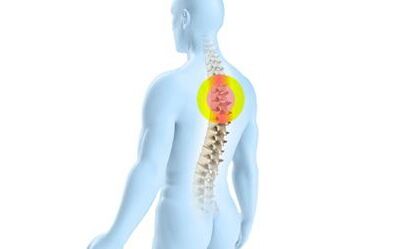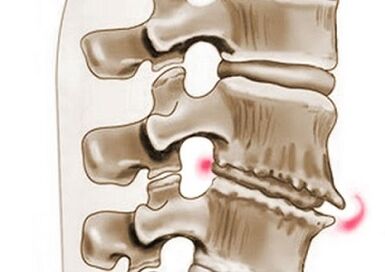Osteochondrosis of the thoracic spine is a rare pathology and the "most insidious form" of osteochondrosis. Due to the anatomical conditions, this part of the spine is relatively seldom subject to degeneration. The twelve vertebrae of the department are very tightly connected and are perfectly protected by a kind of muscle corset, which significantly restricts the freedom of movement between them. The ribs give the vertebrae additional rigidity.

The most likely reason for breast osteochondrosis to form is scoliosis, which is formed even at school. The risk factor for damaging the intervertebral disc can be:
- hereditary factor;
- improper diet and obesity;
- Work activity connected with restriction of movement;
- exorbitant physical activity;
- Age factor and hypothermia;
- Instability of the segments of the intervertebral discs;
- Smoking and nervous stress;
- Bruises, fractures, and injuries to the spine are the most beneficial factors in developing thoracic osteochondrosis.
Symptoms and signs
One of the hallmarks of breast osteochondrosis is pain. It is common to divide it into types:
- Lumbago - Dorsago. The manifestation of acute, sudden pain in the area of the affected intervertebral discs. Symptoms of thoracic spine osteochondrosis are the result of prolonged sitting position, when you have to sit at a table and bend over for a long time. Sharp pain (lumbago) occurs when you try to stand or straighten up.
- Dorsalgia. Increased pain when trying to inhale deeply and move the trunk. The back muscles are tense and movement can be restricted in any region of the spine.
Visceral (internal) manifestations
With osteochondrosis of the breast, the symptoms are rich in internal (visceral) manifestations.
The defeat of the upper thoracic nerve roots causes pain in the esophagus and throat.
Pressure on the affected area of the spine causes increased pain. It can be paroxysmal.
Symptoms of osteochondrosis of the chest region, which are manifested by pain in the stomach, indicate damage to the nerve endings of the middle chest region, which causes increased pain when lying on the back for a long time.
The compression of the 8th and 9th spinal roots causes pain in the duodenal area. The sensitivity of the front part of the abdominal wall is impaired.
Abnormal gastric motility (secretion and peristalsis) is a characteristic symptom of osteochondrosis of the chest.
Result:
- Nausea and vomiting;
- Heartburn;
- Pain in the left hypochondrium;
- Flatulence;
- Diarrhea or constipation.
Dysfunction of the duodenum (secretory and motor) lead to:
- Nausea and belching;
- pain and heaviness in the right hypochondrium.
Very often, osteochondrosis of the chest region is manifested by symptoms characteristic of other diseases, for example, angina pectoris. At the same time, heart pain is noted: cutting, pressing, burning of the heart or squeezing the throat.
With laryngospasm - the result of a pathology at the level of the cervical vertebrae, symptoms develop that are manifested:
- Shortness of breath and cough;
- Wheezing;
- Shortness of breath.
In the treatment of thoracic osteochondrosis, the symptoms and manifestations of which are similar to those of pulmonary pathology, it is necessary to accurately establish its involvement in the disease of the spine.
Treatment of osteochondrosis of the thoracic spine
When drawing up a treatment plan that defines the treatment of osteochondrosis of the chest region, diagnostic data based on an X-ray examination will help. Such an examination gives a clear idea of the treatment of thoracic osteochondrosis, since x-rays showing the proliferation of vertebral bodies and the presence of changes in intervertebral spacing (decrease in height) are a characteristic symptom of this disease.
Based on the data of the diagnostic examination, the main symptoms are determined, the clinical diagnosis is clarified, which makes it possible to determine the correct tactics.
Treatment of osteochondrosis of the thoracic spine directly depends on the syndromes, stage of development and the presence of background diseases.
To relieve pain, restore impaired functions of the nerves of the roots of the spine, prevent the progression of degenerative changes in the structure of the spine, a conservative method is used, combined with complex, step-by-step treatment.
Treatment of breast osteochondrosis includes a number of physiotherapeutic procedures:
- Inductometry and electrophoresis;
- Laser therapy and vacuum therapy;
- sinusoidally modeled and diadynamic currents;
- Magneto- and pharmacopuncture;
- Acupuncture.
Drug Therapy:
- vascular regulating diuretics and muscle relaxants (muscle relaxants and venotonics);
- paravertebral novokoin blockade.
physical therapy
Physiotherapy for thoracic osteochondrosis is the main stage in the recovery process. Strengthens the muscles and mobility of the spine. Exercise in osteochondrosis of the chest helps improve ventilation in patients in whom deep breathing is painful.
Gymnastics for osteochondrosis of the chest region is effective:
- when the spine is stretched;
- in setting proper breathing.
But we must not forget that gymnastics for thoracic osteochondrosis is effective only if all the causes of the disease are identified and eliminated.
If the prescribed course of treatment did not bring positive results, then based on the pronounced symptoms and degree of destruction, various methods of surgical intervention are used.
Cervicothoracic osteochondrosis
Cervicothoracic osteochondrosis is a disease caused by processes (degenerative-dystrophic) that affect the intervertebral discs of the cervical spine.
Vertebrae that are close together are not adequately protected by a relatively poorly developed muscle frame. Even the slightest strain on the neck causes myelopathy.
Main symptoms

Symptoms of cervicothoracic osteochondrosis are manifested:
- disruption of the sensitivity of the muscles of the neck, skin, hands and face;
- Headache and dizziness;
- Unsteadiness of gait;
- increased tiredness, eyesight and hearing deteriorate.
The pain radiates into the arm, extends from the shoulder to the fingertips, causes numbness of the skin, even a slight movement of the neck can cause a feeling of electrical current along the entire arm.
Myelopathy can cause:
- Diseases of the lungs and heart;
- Double vision;
- Numbness of the tongue.
Treatment of exacerbation of the disease
The use of complex therapy in the treatment of exacerbation of cervicothoracic osteochondrosis allows a permanently positive result. It contains:
- The method of orthopedic correction is the fixation of the neck with the Chance collar, which supports the head, significantly relieves the cervical vertebrae and helps to align them.
- The method with pharmacopuncture - anti-inflammatory drugs (preferably homeopathic) to relax spasmodic muscles and prevent the deterioration of radicular compression.
- Chondroprotectors - to prevent the development of cartilage tissue damage.
- Medicines that help to strengthen the intervertebral disc apparatus.
- Acupuncture is used to quickly relieve pain, relieve muscle spasms, and restore spinal nerve function. This method is very effective, and its use during an exacerbation will prevent the disease from progressing for many years.
- Hirudotherapy - treatment with leeches promotes scarring of damaged fiber rings in the intervertebral discs, eliminates edema of the nerve roots and improves blood flow to the intervertebral discs of the spine.
- Drug therapy - biogenic stimulants, drugs to improve peripheral blood circulation, vitamins.
- Massage - to relax, restore and strengthen spasmodic muscles.
In the final period of treatment, subject to the elimination of muscle spasms and inflammatory processes, they combine - manual therapy, osteopathy, exercise therapy.
Timely treatment of any disease will prevent exacerbations and various complications caused by them.





































